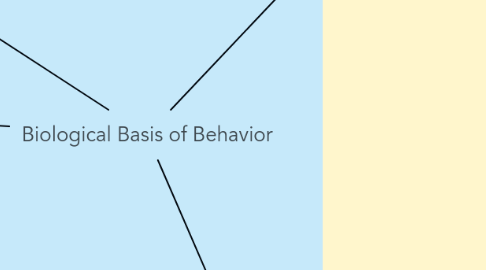
1. The Nervous System
1.1. How do we Examine the nervous System?
1.1.1. EEG: tracks and records brain waves via receptors on the scalp
1.1.2. CT: An x-ray that shows details of body organs
1.1.3. PET: Image that reveals how your organs are functioning
1.1.4. MRI: Detailed image of the body's tissues and bones
1.2. fMRI: Measures brain usage
1.3. Neuron: A nerve cell
1.3.1. Synapse: Gap between neurons
1.3.2. Motor neurons: Take impulses from brain to muscles
1.3.3. Sensory neurons: Take outer stimuli and converts them into internal impulses.
1.3.4. Interneuron: neuron that communicates between neurons
1.3.5. Dendrite: Branch like structures on a neuron that receive synapsis
1.3.6. Axon: Protruding structure from a neuron that sends impulses
1.3.6.1. Myelin sheath: Fatty covering of the axon.
1.3.7. Action Potential: the impulse
1.3.8. Threshold: how much of the impulse
1.3.9. Reuptake: the retreat of the impulse
1.4. Nervous System: Network of nerves that send and retrieves impulses
1.4.1. Peripheral Nervous System:The outside nervous system excluding the brain and spinal chord
1.4.1.1. Autonomic Nervous System: System of involuntary movements
1.4.1.1.1. Sympathetic Nervous System: Fight or Flight?
1.4.1.1.2. Parasympathetic Nervous System: Actions that don't need immediate reaction (sexual arousal)
1.4.1.2. Somatic Nervous System: System of voluntary movements
1.4.2. Central Nervous Sytem: Brain and spinal chord, it controls activities
1.4.2.1. Glial Cells: support and protect neurons in the CNS
1.5. Endocrine System: glands that secrete hormones
2. Genetics
2.1. Robert Plomin: Studies Genetics
2.2. Natural Selection: Survival of the fittest
2.2.1. Darwin: NATURAL SELECTION!
2.3. Identical Twins: Twins born from a split egg and a single sperm cell.
2.3.1. Thomas Bouchard: Studied identical twins separated at birth, Jim twins
2.3.2. David Lykken: Best known for lie tests and twin studies
2.4. Genes: The genetic instruction inside of a chromosome
2.4.1. Chromosomes: Thread like structures in nucleus of cells
2.4.2. Francis Collins: Said we can look at genome to see how you will be
2.5. Behavior Genetics: Study of environmental and genetic influences on behavior
2.6. Fraternal twins: Twins from two separately fertilized eggs.
2.7. Heritability: statistic that measures degree of genetic variation
3. David Buss: Studies in evolutionary psych. and mate selection
4. Wendy wood: study of psychology of gender and habits of behavior change
5. The physical brain
5.1. Consciousness: Awareness of self
5.1.1. Dual Processing: Theory that thoughts come from controlled and uncontrolled processes.
5.2. The Forebrain
5.2.1. Thalamus: Gray matter between brain hemispheres
5.2.2. Limbic System: Controls instinct and mood
5.2.2.1. Amygdala: 1 on each side, emotions, mood, and instincts.
5.2.3. Hypothalamus: Connects endocrine system to nervous system
5.2.4. Cerebral Cortex: Largest part of brain, controls higher brain functions
5.2.4.1. Motor Cortex: Where muscle impulses start
5.2.4.2. Frontal Lobes: behavior, learning, personality, voluntary movement.
5.2.4.2.1. Broca's Area: functions linked to speech production
5.2.4.3. Parietal Lobes: Reception and correlation of senses
5.2.4.4. Occipital: Visual processing center
5.2.4.5. Temporal: Understanding of speech
5.2.4.5.1. Wenicke's Area: Place of comprehension of speech
5.2.4.6. Corpus Collosum: Nerve fibers that join the two hemispheres
5.2.5. Sensory Cortex: receives all sensory inputs
5.3. The Midbrain
5.3.1. Brainstem: Trunk of brain
5.3.1.1. Medulla Oblongata: lowest part of brainstem, controls lungs and heart.
5.3.1.2. Reticular Formation: Connects brainstem to spinal chord, cerebrum, and cerebellum. Controls Consciousness
5.3.1.3. Cerebellum: Back base of brain. It regulates and coordinates your muscles
5.4. Michael Gazzniga: Professor of cognitive neuroscience
6. Brain Disorders/Conditions
6.1. Phineas Gage: Had a pole through his head but could still speak and walk
6.2. Plasticity: The brain's ability to change due to experience
6.2.1. Rosenweig, Bennett, and Diamond: Conducted experiments to see how plasticity worked.
6.3. Parkinson's: Affecting midbrain that limits movement, includes tremors
6.4. Aphasia: disorder affecting speech and language skills, from damage or illness.
6.4.1. Karl Wernicke: Conducted research of Aphasia.
6.5. Split Brain: The corpus Collosum is severed
6.5.1. Roger Sperry: Conducted split brain research

